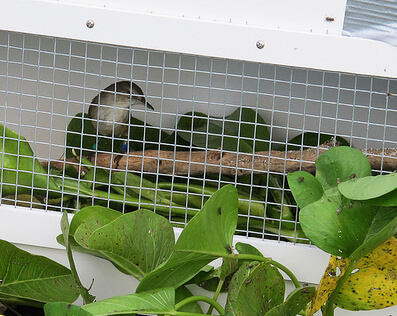Expedition Captures 26 Rare Millerbirds, Releases Them Safely at New Home on Remote Hawaiian Island
 |
| Millerbird in release cage by Chris Farmer, ABC |
   | ||
(Honolulu, HI, September 4, 2012) The second phase of an ambitious and historic effort to save one of the United States' rarest bird species from extinction reached another milestone as a group of 26 Millerbirds captured on Nihoa Island was released by biologists on the northwestern Hawaiian island of Laysan, some 650 miles away.
This second such translocation took place between August 12 and August 18, and was carried out by a team of biologists from the U.S. Fish and Wildlife Service (FWS), American Bird Conservancy (ABC), and other organizations as part of a multi-year effort to restore Millerbirds to Laysan Island within the Hawaiian Islands National Wildlife Refuge and Papahanaumokuakea Marine National Monument and World Heritage site.
Millerbirds have been absent from Laysan for almost a century as a result of habitat destruction due to introduced rabbits and other livestock. The last of these animals was removed from Laysan in the early 20th Century. FWS has been working to restore Laysan's native vegetation for more than two decades. A self-sustaining Millerbird population on Laysan will ensure that the species is no longer vulnerable to extinction from a catastrophic event on Nihoa such as a hurricane or the accidental introduction of an alien predator or disease.
Last year, in the highly successful first phase of the translocation effort, 24 Millerbirds were moved from Nihoa to Laysan. Since their September 10, 2011, release this pioneer group of birds has survived and thrived, producing 17 young. The birds that are part of the second translocation also were captured on Nihoa and transported on a three-day boat trip to Laysan.
“So far, everything has gone extremely well for the birds,” said Sheila Conant of the University of Hawai‘i, who pioneered the study of Millerbirds on Nihoa in the 1980s and is a member of this year's translocation team. “They were captured without incident; they made it through the boat ride in good health; we had no problems attaching transmitters to them; and they have now been released to their new habitat without a hitch. So we are thrilled with the way this phase has gone.”
With the 24 Millerbirds brought to Laysan last year, “the team has now translocated 50 “founder” Millerbirds—the initial target number set by the conservation team for giving the species the best possible chance of establishing a self-sustaining population on Laysan,” said Don Palawski, Acting FWS Superintendent of the Papahanaumokuakea Marine National Monument, which encompasses the Northwestern Hawaiian Islands.
During the voyage from Nihoa to Laysan aboard the vessel M/V Searcher, the Millerbirds were cared for by avian husbandry experts and a wildlife veterinarian from the U.S. Geological Survey. The itinerary included several days on Nihoa to capture the birds and allow them to acclimate to captivity prior to the sea voyage to Laysan, and three days on Laysan to release the birds and initiate radio-tracking of their movements. A Native Hawaiian cultural liaison accompanied the biologists on the translocation voyage and remained on Nihoa with the biological monitoring team. Two biologists will remain on Laysan through the end of October, and one will remain through the winter to monitor the newly released Millerbirds, the young produced in 2012, and the adults translocated in 2011.
“Certainly, there is much more to be done before we can say ‘we did it' but I think everyone is satisfied that our plans were well thought-out and well-executed in a seamless and highly professional fashion, said George Wallace, ABC Vice President for Oceans and Islands. “So far, the results are even better than we had hoped.”
“This would not have been possible without a talented, dedicated team of biologists and a bird that is tough enough to withstand a three-day sea voyage of over 600 miles while retaining enough moxie to grab flies out of the air while a radio-transmitter is being glued to its back!” said Sheldon Plentovich, FWS Coastal Program Coordinator for the Pacific Islands, and lead biologist on the Millerbird project.
The Millerbird, which weighs less than an ounce, is a lively gray and brown bird that forages for insects among low shrubs and bunch-grasses. On Laysan, it joins the Laysan Finch, Laysan Duck, Hawaiian monk seal, several endangered plant species, and millions of nesting seabirds.
Close observation of the first group of translocated Millerbirds over the past 11 months has yielded significant new scientific information about the species, such as details of breeding chronology, the fact that pairs can produce more than one brood in a season, and a still-emerging picture of how young birds mature and enter the breeding population. All this information is important in assessing the progress toward population establishment on Laysan and is valuable in the conservation and management of the species. The success to date indicates that Laysan has suitable habitat and adequate food resources to support Millerbirds.
As a co-manager of the Papahanaumokuakea Marine National Monument and World Heritage Site, the FWS is proud to lead this project in collaboration with American Bird Conservancy. We are grateful for the support and assistance from the National Fish and Wildlife Foundation, the University of New Brunswick, University of Hawai‘i, the U.S. Geological Survey National Wildlife Health Research Center, and the Office of Hawaiian Affairs.
To learn more about the Millerbird project and read updates from Laysan, visit here and here.
Note: Project images can be downloaded from USFWS's Flickr.


















































